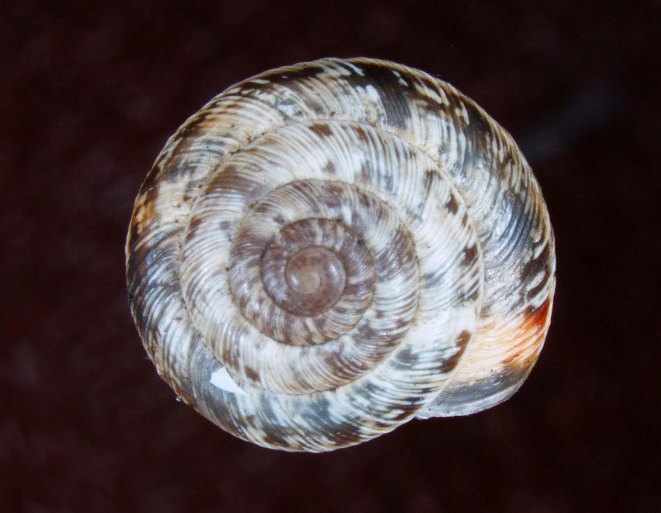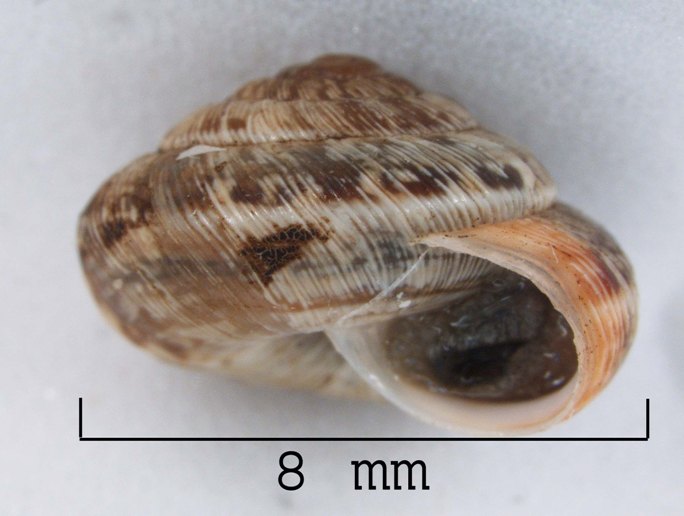Candidula intersecta
Detection of populations of the exotic snail Candidula intersecta in Oregon
February 1, 2007 update
Summary
Since 2003, PPQ-Oregon has conducted detection surveys for exotic mollusk species at high-risk sites throughout Oregon. The Oregon Exotic Mollusk Survey (ORMS) has surveyed over 80 sites, representing 16 Oregon counties (Benton, Clackamas, Clatsop, Columbia, Coos, Curry, Douglas, Jackson, Klamath, Lane, Lincoln, Marion, Multnomah, Polk, Washington, Yamhill counties). Surveyed sites have included marine ports, rail yards, tile importers and distributors, nurseries, private residential and public lands.
The exotic snail Candidula intersecta has recently been detected at seven sites in southern Oregon, including four sites in Coos Bay (Coos County), and single sites in Frankport, Gold Beach and Port Orford. Morphological identification has been confirmed by the USDA regional and national malacologists. Candidula intersecta, or the wrinkled dune snail, is considered by the USDA to be a potential agricultural pest. All seven positive sites are located on the southern Oregon coast, at active or historical port sites. The density and range of the infestations at each site is currently unknown; however, preliminary estimates of the total infested area in Oregon is 142 acres, minimum. Follow-up delimitation survey will need to be conducted to provide further information. No state or federal quarantine or control activities have been initiated yet.
Candidula intersecta are frequently intercepted at the Port of Portland on cargo containers from Italy, Colombia, and Chile and are considered “Actionable” by PPQ (PIN-309 database; D. Robinson, USDA). The species originates in northern Europe, but is also naturalized in New Zealand and Australia, where it is commonly reported in open, dry environments, including pastures (G. Barker 2002. Molluscs as Crop Pests), and “habitats such as coastal dunes, exposed limestone outcrops, open scrub…” at altitudes from 0 to 800masl. (G. Barker 1999. Fauna of New Zealand).
Based on historical observations, Candidula intersecta may exhibit behaviors that can cause agricultural impacts in the state of Oregon. In Europe, Candidula snails are a recognized pest of apples, pears, plums and peaches, damaging fruit while still on the tree, which allows fungal attack and fruit rot (D. Godan 1983, Pest Slugs and Snails). These snails are also reported to cause feeding damage to seeds, seedlings and young plants of spring grain. When populations reach high numbers, this species may exhibit a “massing behavior” where the snails climb and enter a dormant state on plants or other structures. This massing behavior has been reported to contaminate grain fields during harvest, resulting in downgraded quality and loss of marketability.
It is not currently known if this snail is established in Oregon's grass seed or grain producing areas. No economic impact has been reported in Oregon from these snail infestations. No quarantine or control activities have been initiated. The USDA New Pest Advisory Group is reviewing the known background information and preparing a pest risk assessment for this species. Further surveys are being planned.
Mark Hitchcox
Pest Survey Specialist
USDA-APHIS-PPQ
Portland, Oregon
(503) 326-2919 x228
Page last modified 2/9/07
Photo: Mark Hitchcox/APHIS
Ventral view of the shell of Candidula intersecta
Photo: Mark Hitchcox/APHIS
Striations on the shell of Candidula intersecta





